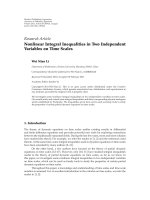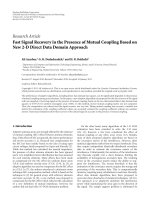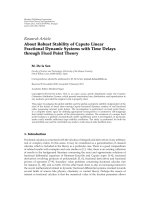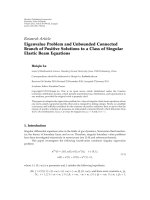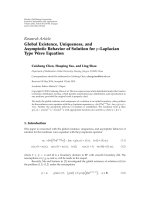Báo cáo hóa học: "Research Article Global Asymptotic Stability in a Class of Difference Equations" docx
Bạn đang xem bản rút gọn của tài liệu. Xem và tải ngay bản đầy đủ của tài liệu tại đây (483.67 KB, 7 trang )
Hindawi Publishing Corporation
Advances in Difference Equations
Volume 2007, Article ID 16249, 7 pages
doi:10.1155/2007/16249
Research Article
Global Asymptotic Stability in a Class of Difference Equations
Xiaofan Yang, Limin Cui, Yuan Yan Tang, and Jianqiu Cao
Received 29 April 2007; Accepted 5 November 2007
Recommended by John R. Graef
We study the difference equation x
n
= [( f × g
1
+ g
2
+ h)/(g
1
+ f × g
2
+ h)](x
n−1
, ,x
n−r
),
n
= 1,2, , x
1−r
, ,x
0
> 0, where f ,g
1
,g
2
:(R
+
)
r
→ R
+
and h :(R
+
)
r
→ [0,+∞)areall
continuous functions, and min
1≤i≤r
{u
i
,1/u
i
}≤ f (u
1
, ,u
r
) ≤ max
1≤i≤r
{u
i
,1/u
i
},
(u
1
, ,u
r
)
T
∈ (R
+
)
r
. We prove that this difference equation admits c = 1astheglobally
asymptotically stable equilibrium. This result extends and generalizes some previously
known results.
Copyright © 2007 Xiaofan Yang et al. This is an open access article dist ributed under the
Creative Commons Attribution License, which permits unrestricted use, distribution,
and reproduction in any medium, provided the original work is properly cited.
1. Introduction
Ladas [1] suggested investigating the nonlinear difference equation
x
n
=
x
n−1
+ x
n−2
x
n−3
x
n−1
x
n−2
+ x
n−3
, n = 1,2, , x
−2
,x
−1
,x
0
> 0. (1.1)
Since then, it has been proved that c
= 1 is the common globally asymptotically sta-
ble equilibrium of this difference equation and al l of the fol l owing difference equations
(where a and b are nonnegative constants):
x
n
=
x
n−2
+ x
n−1
x
n−3
x
n−1
x
n−2
+ x
n−3
, n = 1,2, , x
−2
,x
−1
,x
0
> 0 (see [1]),
(1.2)
x
n
=
x
n−1
x
n−2
+ x
n−3
+ a
x
n−1
+ x
n−2
x
n−3
+ a
, n
= 1,2, , x
−2
,x
−1
,x
0
> 0 (see [6,12]),
(1.3)
x
n
=
x
n−2
+ x
n−1
x
n−3
+ a
x
n−1
x
n−2
+ x
n−3
+ a
, n
= 1,2, , x
−2
,x
−1
,x
0
> 0 (see [6]),
(1.4)
2AdvancesinDifference Equations
x
n
=
x
n−1
+ x
n−2
x
n−3
+ a
x
n−1
x
n−2
+ x
n−3
+ a
, n
= 1,2, , x
−2
,x
−1
,x
0
> 0 (see [14]),
(1.5)
x
n
=
x
n−1
x
n−2
+ x
n−3
+ a
x
n−2
+ x
n−1
x
n−3
+ a
, n
= 1,2, , x
−2
,x
−1
,x
0
> 0 (see [14]),
(1.6)
x
n
=
x
b
n
−1
x
n−3
+ x
b
n
−4
+ a
x
b
n
−1
+ x
n−3
x
b
n
−4
+ a
, n
= 1,2, , x
−3
,x
−2
,x
−1
,x
0
> 0 (see [7]),
(1.7)
x
n
=
x
b
n
−k
x
n−m
+ x
b
n
−l
+ a
x
b
n
−k
+ x
n−m
x
b
n
−l
+ a
, n
= 1,2, , x
1−max{k,m,l}
, ,x
0
> 0 (see [8]). (1.8)
Motivated by the above work and the work by Sun and Xi [2], this article addresses the
difference equation
x
n
=
f × g
1
+ g
2
+ h
g
1
+ f × g
2
+ h
x
n−1
, ,x
n−r
, n = 1,2, , x
1−r
, ,x
0
> 0, (1.9)
where f , g
1
,g
2
:(R
+
)
r
→R
+
and h :(R
+
)
r
→[0,+∞) are all continuous functions, and
min
1≤i≤r
u
i
,1/u
i
≤
f
u
1
, ,u
r
≤
max
1≤i≤r
u
i
,1/u
i
,
u
1
, ,u
r
T
∈
R
+
r
. (1.10)
It can be seen that (1.9)subsumes(1.1)and(1.8). For example, if we let r
= max{k,l,m},
f (x
n−1
, ,x
n−r
) = x
n−m
, g
1
(x
n−1
, ,x
n−r
) = x
b
n
−k
, g
2
(x
n−1
, ,x
n−r
) = x
b
n
−l
,andh(x
1
, ,
x
r
) ≡ a,then(1.9)reducesto(1.8).
We prove that ( 1.9)admitsc
= 1 as the globally asymptotically stable equilibrium. As
a consequence, our result includes all of the above-mentioned results.
2. Preliminary knowledge
For two functions, f (x
1
, ,x
n
)andg(x
1
, ,x
n
), we adopt the following notations:
[ f + g]
x
1
, ,x
n
:= f
x
1
, ,x
n
+ g
x
1
, ,x
n
,
f × g]
x
1
, ,x
n
:= f
x
1
, ,x
n
×
g
x
1
, ,x
n
,
f
g
x
1
, ,x
n
:=
f
x
1
, ,x
n
g
x
1
, ,x
n
if g
x
1
, ,x
n
=
0.
(2.1)
Let R
+
denote the whole set of positive real numbers. The part metric (or Thompson’s
metric) [3, 4]isametricdefinedon(R
+
)
r
in the following way: for any X = (x
1
, ,x
r
)
T
∈
(R
+
)
r
and
Y
=
y
1
, , y
r
T
∈
R
+
r
, p(X,Y):=−log
2
min
1≤i≤r
x
i
/y
i
, y
i
/x
i
. (2.2)
Xiaofan Yang et al. 3
Theorem 2.1 (see [5, Theorem 2.2], see also [3]). Let T :(R
+
)
r
→(R
+
)
r
beacontinuous
mapping with an equilibrium C
∈ (R
+
)
r
. Consider the following difference equation:
X
n
= T
X
n−1
, n = 1,2, , X
0
∈
R
+
r
. (2.3)
Suppose there is a positive integer k such that p(T
k
(X),C) <p(X,C) holds for all X = C.
Then C is globally asymptotically stable.
Theorem 2.2 (see [6, page 1]). Let a
1
, ,a
n
, b
1
, ,b
n
, c
1
, ,c
n
be positive numbers.
Then
min
a
i
b
i
:1≤ i ≤ n
≤
n
i
=1
c
i
a
i
n
i
=1
c
i
b
i
≤ max
a
i
b
i
:1≤ i ≤ n
. (2.4)
Moreover, one of the two equalities holds if and only if a
1
/b
1
= a
2
/b
2
=··· =a
n
/b
n
.
3. Main result
The main result of this article is the following.
Theorem 3.1. Consider the difference equation
x
n
=
f × g
1
+ g
2
+ h
g
1
+ f × g
2
+ h
x
n−1
, ,x
n−r
, n = 1,2, , x
1−r
, ,x
0
> 0, (3.1)
where f ,g
1
,g
2
:(R
+
)
r
→R
+
and h :(R
+
)
r
→[0,+∞) are all continuous functions, and
min
1≤i≤r
u
i
,1/u
i
≤
f
u
1
, ,u
r
≤
max
1≤i≤r
u
i
,1/u
i
,
u
1
, ,u
r
T
∈
R
+
r
. (3.2)
Let
{x
n
} be a solution of (3.1). Then the following assertions hold:
(i) for all n
≥ 1andj≥ 0, one has
min
1≤i≤r
x
n−i
,1/x
n−i
≤
x
n+ j
≤ max
1≤i≤r
x
n−i
,1/x
n−i
; (3.3)
(ii) there exist n
≥ 1andj≥ 0 s uch that one of the two equalities in chain (3.3)holdsif
and only if (x
n−1
, ,x
n−r
) = (1, ,1);
(iii) c
= 1 is the globally asymptotically stable equilibrium of (3.1).
4AdvancesinDifference Equations
Proof. (i) For any g iven n
≥ 1, we prove t he assertion by induction on j.ByTheorem 2.2
and chain (3.3), we have
x
n
=
f × g
1
+ g
2
+ h
g
1
+ f × g
2
+ h
x
n−1
, ,x
n−r
≥
min
f
x
n−1
, ,x
n−r
,
1
f
x
n−1
, ,x
n−r
≥
min
min
1≤i≤r
x
n−i
,1/x
n−i
,
1
max
1≤i≤r
x
n−i
,1/x
n−i
=
min
1≤i≤r
x
n−i
,1/x
n−i
,
x
n
=
f × g
1
+ g
2
+ h
g
1
+ f × g
2
+ h
x
n−1
, ,x
n−r
≤
max
f
x
n−1
, ,x
n−r
,
1
f
x
n−1
, ,x
n−r
≤
max
max
1≤i≤r
x
n−i
,1/x
n−i
,
1
max
1≤i≤r
x
n−i
,1/x
n−i
=
max
1≤i≤r
x
n−i
,1/x
n−i
.
(3.4)
So the assertion is true for j
= 0.
Suppose the assertion is true for all integer k (0
≤ k ≤ j − 1), that is,
min
1≤i≤r
x
n−i
,1/x
n−i
≤
x
n+k
≤ max
1≤i≤r
x
n−i
,1/x
n−i
,0≤ k ≤ j − 1. (3.5)
By Theorem 2.2, chain (3.2), and the inductive hypothesis, we get
x
n+ j
=
f × g
1
+ g
2
+ h
g
1
+ f × g
2
+ h
x
n+ j−1
, ,x
n+ j−r
≥
min
f
x
n+ j−1
, ,x
n+ j−r
,
1
f
x
n+ j−1
, ,x
n+ j−r
≥
min
min
1≤i≤r
x
n+ j−i
,1/x
n+ j−i
,
1
max
1≤i≤r
x
n+ j−i
,1/x
n+ j−i
=
min
1≤i≤r
x
n+ j−i
,1/x
n+ j−i
≥
min
min
1≤i≤r
x
n−i
,1/x
n−i
,
1
max
1≤i≤r
x
n−i
,1/x
n−i
=
min
1≤i≤r
x
n−i
,1/x
n−i
;
(3.6)
x
n+ j
=
f × g
1
+ g
2
+ h
g
1
+ f × g
2
+ h
x
n+ j−1
, ,x
n+ j−r
≤
max
f
x
n+ j−1
, ,x
n+ j−r
,
1
f
x
n+ j−1
, ,x
n+ j−r
≤
max
max
1≤i≤r
x
n+ j−i
,1/x
n+ j−i
},
1
min
1≤i≤r
x
n+ j−i
,1/x
n+ j−i
}
=
max
1≤i≤r
x
n+ j−i
,1/x
n+ j−i
≤
max
max
1≤i≤r
x
n−i
,1/x
n−i
,
1
min
1≤i≤r
x
n−i
,1/x
n−i
=
max
1≤i≤r
x
n−i
,1/x
n−i
.
(3.7)
Thus the assertion is true for j. The inductive proof of this assertion is complete.
Xiaofan Yang et al. 5
(ii) The sufficiency follows immediately from the first assertion of this theorem. Ne-
cessity. Suppose there exist n
≥ 1andj ≥ 0suchthatx
n+ j
= min
1≤i≤r
{x
n−i
,1/x
n−i
}.Then
all of the equalities in chain (3.6) hold. This chain of equalities plus Theorem 2.2 yield
f (x
n+ j−1
, ,x
n+ j−r
) = 1and,hence,(x
n−1
, ,x
n−r
) = (1, ,1). Likewise, one can show
that (x
n−1
, ,x
n−r
) = (1, ,1) if x
n+ j
= max
1≤i≤r
{x
n−i
,1/x
n−i
}.
(iii) The system of first-order difference equations associated with (3.1)is
Y
n
= T(Y
n−1
), n = 1,2, , (3.8)
where T :(R
+
)
r
→(R
+
)
r
is a mapping defined by
T
y
1
, , y
r
T
=
y
2
, , y
r
,
f × g
1
+ g
2
+ h
g
1
+ f × g
2
+ h
y
r
, , y
1
T
. (3.9)
By chain (3.2), we have f (1, ,1)
= 1. Hence, C = (1, ,1)
T
is an equilibrium of sys-
tem (3.8). Consider an arbitrary X
= (x
1
, ,x
r
)
T
∈ (R
+
)
r
, X =C.Then
T
r
x
1
, ,x
r
T
=
x
r+1
, ,x
2r
T
, (3.10)
where x
j
= [( f × g
1
+ g
2
+ h)/(g
1
+ f × g
2
+ h)](x
j−1
, ,x
j−r
), r +1≤ j ≤ 2r. By the first
two assertions of this theorem, we induce
min
r+1≤i≤2r
x
i
,1/x
i
> min
min
1≤i≤r
x
i
,1/x
i
,
1
max
1≤i≤r
x
i
,1/x
i
=
min
1≤i≤r
x
i
,1/x
i
. (3.11)
Hence,
p
T
r
X
,C
=−
log
2
min
r+1≤i≤2r
x
i
,1/x
i
< −log
2
min
1≤i≤r
x
i
,1/x
i
=
p
X,C
. (3.12)
By Theorem 2.1,weconcludethatC is the global ly asymptotically stable equilibrium of
system (3.8). This implies that c
= 1 is the globally asymptotically stable equilibrium of
(3.1).
4. Applications
Example 4.1. Consider the difference equation
x
n
=
f × g
1
+ g
2
+ h
g
1
+ f × g
2
+ h
x
n−1
, ,x
n−r
, n = 1,2, , x
1−r
, ,x
0
> 0, (4.1)
where g
1
,g
2
:(R
+
)
r
→R
+
and h :(R
+
)
r
→[0,+∞) are all continuous functions, 1 ≤ p ≤ r,
1
≤ q ≤ r,1≤ s ≤ r, f
u
1
, ,u
r
=
u
p
+ u
q
+ u
s
/3, and
u
1
, ,u
r
T
∈
R
+
r
.
As f (u
1
, ,u
r
) is the arithmetic mean of u
p
, u
q
,andu
s
,weget
f
u
1
, ,u
r
≤
max
u
p
,u
q
,u
s
≤
max
1≤i≤r
u
i
,1/u
i
,
f
u
1
, ,u
r
≥
min
u
p
,u
q
,u
s
≥
min
1≤i≤r
u
i
,1/u
i
.
(4.2)
By Theorem 3.1, c
= 1 is the globally asymptotically stable equilibrium of (4.1).
6AdvancesinDifference Equations
Example 4.2. Consider the difference equation
x
n
=
f × g
1
+ g
2
+ h
g
1
+ f × g
2
+ h
x
n−1
, ,x
n−r
, n = 1,2, , x
1−r
, ,x
0
> 0, (4.3)
where g
1
,g
2
:(R
+
)
r
→R
+
and h :(R
+
)
r
→[0,+∞) are all continuous functions, 1 ≤ p ≤ r,
1
≤ q ≤ r,1≤ s ≤ r, f (u
1
, ,u
r
) = (u
p
+ u
q
+1/u
s
/3, and
u
1
, ,u
r
T
∈
R
+
r
.
As f (u
1
, ,u
r
) is the arithmetic mean of u
p
, u
q
,and1/u
s
,weget
f
u
1
, ,u
r
≤
max{u
p
,u
q
,1/u
s
≤
max
1≤i≤r
u
i
,1/u
i
,
f
u
1
, ,u
r
≥
min
u
p
,u
q
,1/u
s
≥
min
1≤i≤r
u
i
,1/u
i
,
(4.4)
By Theorem 3.1, c
= 1 is the globally asymptotically stable equilibrium of (4.3).
Example 4.3. Consider the difference equation
x
n
=
f × g
1
+ g
2
+ h
g
1
+ f × g
2
+ h
x
n−1
, ,x
n−r
, n = 1,2, , x
1−r
, ,x
0
> 0, (4.5)
where g
1
,g
2
:(R
+
)
r
→R
+
and h :(R
+
)
r
→[0,+∞) are all continuous functions, 1 ≤ p ≤ r,
1
≤ q ≤ r,1≤ s ≤ r, f
u
1
, ,u
r
=
3
u
p
u
q
/u
s
,and
u
1
, ,u
r
T
∈
R
+
r
As f (u
1
, ,u
r
)isthegeometricmeanofu
p
, u
q
,and1/u
s
,weget
f
u
1
, ,u
r
≤
max
u
p
,u
q
,1/u
s
≤
max
1≤i≤r
u
i
,1/u
i
,
f
u
1
, ,u
r
≥
min
u
p
,u
q
,1/u
s
≥
min
1≤i≤r
u
i
,1/u
i
.
(4.6)
By Theorem 3.1, c
= 1 is the globally asymptotically stable equilibrium of (4.5).
5. Conclusions
This article has studied the global asymptotic stability of a class of difference equations.
The result obtained extends and generalizes some previous results. We are attempting to
apply the technique used in this article to deal with other generic difference equations
which include some well-studied difference equations such as those in [7, 8].
Acknowledgments
The authors are grateful to the anonymous reviewers for their valuable comments and
suggestions. This work is supported by Natural Science Foundation of China (Grant no.
10771227), Program for New Century Excellent Talent of Educational Ministry of China
(Grant no. NCET-05-0759), Doctorate Foundation of Educational Ministry of China
(Grant no. 20050611001), and Natural Science Foundation of Chongqing (Grants no.
CSTC 2006BB2231, 2005BB2191).
Xiaofan Yang et al. 7
References
[1] G. Ladas, “Open problems and conjectures,” Journal of Difference Equations and Applications,
vol. 2, no. 4, pp. 449–452, 1996.
[2] T. Sun and H. Xi, “Global attractivity for a family of nonlinear difference equations,” Applied
Mathematics Letters, vol. 20, no. 7, pp. 741–745, 2007.
[3] N. Kruse and T. Nesemann, “Global asymptotic stability in some discrete dynamical systems,”
Journal of Mathematical Analysis and Applications, vol. 235, no. 1, pp. 151–158, 1999.
[4] T. Nesemann, “Positive nonlinear difference equations: some results and applications,” Nonlin-
ear Analysis: Theory, Methods & Applications, vol. 47, no. 7, pp. 4707–4717, 2001.
[5] X. Yang, D. J. Evans, and G. M. Megson, “Global asymptotic stability in a class of Putnam-type
equations,” Nonlinear Analysis: Theory, Methods & Applications, vol. 64, no. 1, pp. 42–50, 2006.
[6] J. Kuang, Applied Inequalities, Shandong Science and Technology Press, Jinan, China, 2004.
[7] K.S.BerenhautandS.Stevi
´
c, “The global att ractivity of a higher order rational difference equa-
tion,” Journal of Mathematical Analysis and Applications, vol. 326, no. 2, pp. 940–944, 2007.
[8] H. Xi and T. Sun, “Global behavior of a higher-order rational difference equation,” Advances in
Difference Equations, vol. 2006, Article ID 27637, 7 pages, 2006.
Xiaofan Yang: College of Computer Science, Chongqing University, Chongqing 400044, China;
School of Computer and Information, Chongqing Jiaotong University, Chongqing 400074, China
Email address: xf
Limin Cui: Department of Computer Science, Hong Kong Baptist University, Kowloon, Hong Kong
Email address:
Yuan Yan Tang: College of Computer Science, Chongqing University, Chongqing 400044, China
Current address: Department of Computer Science, Hong Kong Baptist University,
Kowloon, Hong Kong
Email address:
Jianqiu Cao: School of Computer and Information, Chongqing Jiaotong University,
Chongqing 400074, China
Email address:

